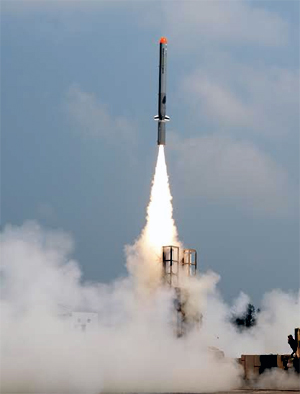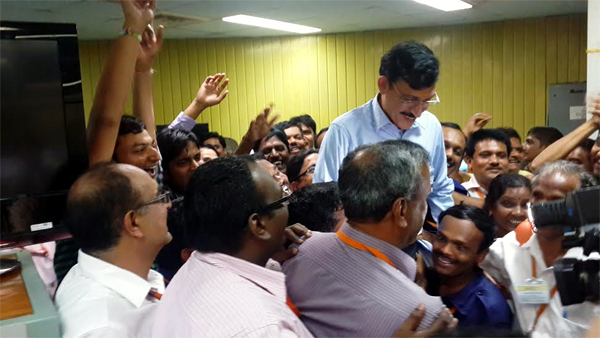| The
flight was tracked by ground radars and telemetry while an Indian Air Force SU
30 MKI aircraft chased it from its majestic liftoff and steady cruise till the
targeted splashdown 73 minutes later in the Bay of Bengal on India’s eastern
seaboard. Dr Avinash Chander, the country’s top defence scientist
and missile man, observed that "the missile maintained an accuracy better
than 10 meters throughout its path and covered a distance of more than 1000 km”
and that the “successful indigenous development of Nirbhay will fill a vital
gap in the war fighting capabilities of our armed forces." Dr Chander
is Director General DRDO, Secretary Department of Defence in the Ministry of Defence
(MoD) and also Scientific Adviser to the Defence Minister. Sources told
India Strategic that
there would be a few more tests to firmly establish its parameters and develop
it into four variants for land, air, sea and underwater deployment. By 2018, Nirbhay
should be with the Indian forces. Nirbhay is reported to have a range of
1500 km however but when asked about the range and payload, DRDO spokesman Dr
Ravi Gupta said that he would not disclose details but pointed out that weight
and range are a matter of configuration also. “For instance, the air-launched
version would not need boosters and still the missile could go for a longer distance.”
There was a dummy payload in the current test.  But
this is a great development in strengthening the country’s deterrence posture,
he said pointing out that Dr Chander was warmly congratulated by the scientists
on Nirbhay’s success. But
this is a great development in strengthening the country’s deterrence posture,
he said pointing out that Dr Chander was warmly congratulated by the scientists
on Nirbhay’s success.
President Pranab Mukherjee, Prime Minister Narendra
Modi and Defence Minister Arun Jaitley congratulated the DRDO team on Nirbhay’s
success. Significantly, 15 waypoints – coordinates – were fed
into Nirbhay programmed flight, and as required, their number could be increased,
enabling it to reach multiple targets. Additionally, Nirbhay would fly at treetop
heights to evade hostile radars. India has a tri-Service Strategic Forces
Command (SFC) to manage deployment of nuclear and other missiles from land, air
and sea, but the trigger is controlled by the Nuclear Command Authority (NCA)
chaired by the country’s Prime Minister. There is a declared policy of No
First Use (NFU) of nuclear weapons but that also mandates massive punitive response
in case of attack. This was the second test of the Nirbhay missile. The
first, in March 2013, had to be terminated for safety reasons due to a component
malfunction in its intertial guidance system and its deviation from the designated
flight path. But it did achieve most of the mission objectives and helped prepare
for the second test. Various systems were then reviewed by experts, some
components replaced and reintegrated with software, and that led to textbook success
in the second launch. The missile is officially described as “long
range” by the Defence Research and Development Organisation (DRDO) which
has actually added several feathers to its crown in successfully developing a
number of missiles. DRDO also has a 50.5 : 49.5 partnership with a Russian company
for the supersonic BrahMos cruise missile but as per the Missile Technology Control
Regime (MTCR), to which Russia is a signatory but - India does not violate –
it is non-nuclear and a limited range of up to 300 km and maximum weight of 500
kg. India is free to develop indigenous nuclear capability and delivery
modules, and that is how, DRDO has been supported by successive governments right
from Prime Minister Indira Gandhi’s time. India’s nuclear and
space programmes are directly controlled by the Prime Minister’s office while
for missiles, DRDO reports to the Defence Minister. Prime Minister Modi’s
Government is encouraging the country’s defence scientists. Dr Gupta
said that the missile was launched from the Integrated Test Range (ITR) at Balasore
in India’s easetern state of Orissa and had “a perfect flight achieving
all the mission objectives.” 
Nirbhay
was powered by a solid rocket motor booster developed by the Advanced Systems
Laboratory (ASL) and fired from a mobile launcher specifically designed for by
the Vehicles Research & Development Establishment (VRDE). “As it
achieved designated altitude and velocity, the booster motor got separated, the
turbofan engine automatically switched on taking over the further propulsion and
the wings opened up by the commands generated by the onboard computer (OBC) stabilising
the flight. Guided by a highly advanced inertial navigation system indigenously
developed by Research Centre Imarat (RCI) the ‘Nirbhay’ continued its
flight that lasted a little over one hour and 10 minutes, he said. Throughout
its path, the missile was tracked with the help of ground based radars and its
health parameters were monitored by indigenous telemetry stations by a team of
professionals from ITR and LRDE (Electronics & Radar Development Establishment).
Additionally, the performance of Nirbhay was closely watched by an Indian Air
Force aircraft. Director ADE P Srikumar led the launch operations. The launch
preparations were planned and supervised by the Nirbhay Project Director Vasanth
Sastri. |